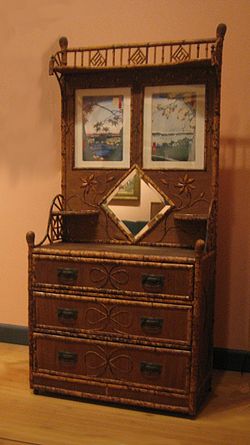
Nimura and Sato
Encyclopedia

Anglo-Japanese style
Anglo-Japanese is a term used to describe a style which developed in the period from approximately 1851 to 1900, when a new awareness of, and appreciation for Japanese design and culture affected the art, especially the decorative art, and architecture of England. The first use of the term occurs...
occasional furniture
Occasional furniture
Occasional furniture refers to small pieces of furniture that can be put to varied uses as the occasion demands. Items such as small tables, nightstands, chests, commodes, and easily moved chairs are usually included in this category....
. It was located at 707 Fulton Street in downtown Brooklyn, New York
Brooklyn
Brooklyn is the most populous of New York City's five boroughs, with nearly 2.6 million residents, and the second-largest in area. Since 1896, Brooklyn has had the same boundaries as Kings County, which is now the most populous county in New York State and the second-most densely populated...
. Since Nimura and Sato also imported furniture from Asia, confusion sometimes arises as to whether a piece bearing the Nimura and Sato label was manufactured by the partnership or merely imported and retailed by them.
Overview
In the late 18th and early 19th centuries, Japan was a pre-industrial society that infused every day objects with a sense of good design, and where handiwork and handcrafts were highly valued. While Japanese ceramics became popular in Britain and North America around the middle of the 19th century, it was not until the 1880s and 1890s that American manufactures, such as Nimura and Sato, began to produce significant quantities of Japanese influencedAnglo-Japanese style
Anglo-Japanese is a term used to describe a style which developed in the period from approximately 1851 to 1900, when a new awareness of, and appreciation for Japanese design and culture affected the art, especially the decorative art, and architecture of England. The first use of the term occurs...
furniture. Such pieces often contained real or simulated (usually turned-maple) bamboo
Bamboo
Bamboo is a group of perennial evergreens in the true grass family Poaceae, subfamily Bambusoideae, tribe Bambuseae. Giant bamboos are the largest members of the grass family....
and woven cane
Caning (furniture)
In the context of furniture, caning is a method of weaving chair seats and other furniture. Caning material is wicker such as cane, or it is derived from the skin of rattan vines native to Indonesia, the Philippines and Malaysia. Some vines reach 500 feet in length. One of the earliest woven chair...
in door panels or tabletops. The Japanese furniture contrasted dramatically with the massive, overstuffed, heavy, dark, and often gaudy Victorian furniture
Victorian decorative arts
Victorian decorative arts refers to the style of decorative arts during the Victorian era. The Victorian era is known for its eclectic revival and interpretation of historic styles and the introduction of cross-cultural influences from the middle east and Asia in furniture, fittings, and Interior...
that had been in vogue.

